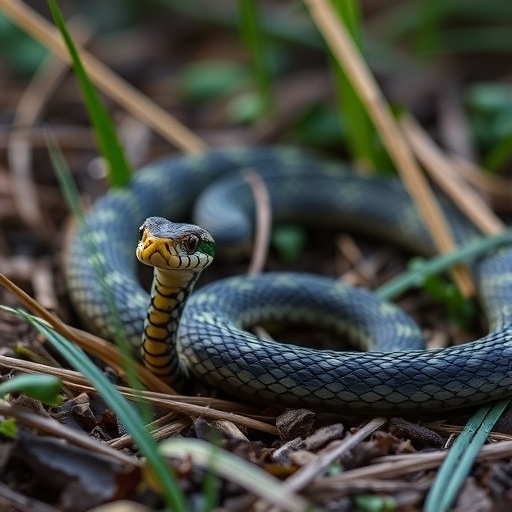In a groundbreaking study published in Frontiers in Zoology, a team of researchers led by Mizsei, Sos, and Móré have shed light on the alarming implications of climate change for grassland vipers. These serpentine inhabitants of meadows and fields are experiencing significant shifts in their activity patterns due to rising temperatures and altered environmental conditions. Drawing from complex mechanistic models, the research underscores the urgent need for conservation strategies to safeguard these reptiles against the relentless march of climate change.
Grassland vipers, particularly those from the Vipera genus, face an increasingly precarious future as climate-induced factors such as habitat fragmentation and temperature variations disrupt their natural behaviors. The researchers employed advanced modeling techniques to simulate the vipers’ activity times under various climatic scenarios, revealing a troubling trend: the frequency and duration of their active periods are poised to increase as the planet warms. The findings detailed in the study reveal an interconnected web of ecological challenges that these reptiles must navigate.
The researchers meticulously documented the vipers’ activity levels across different times of year, correlating these patterns with climatic data gathered over several decades. Their analyses indicated a significant upward shift in the vipers’ active hours, particularly during times traditionally reserved for rest or hiding. This could have profound implications on their feeding behavior, reproduction, and overall survival, as these reptiles adapt to what can only be described as a new normal in temperature and ecological conditions.
One of the most startling aspects of the findings is the interplay between temperature and the vipers’ metabolic rates. As the environment becomes more inhospitable due to climate change, vipers may find themselves unable to effectively regulate their body temperatures, leading to increased stress and decreased physiological performance. For ectothermic animals like vipers, temperature is a critical factor influencing their survival, and changes in available thermal environments may push these species to the brink.
The model also emphasizes the risk of mismatched timing in ecological interactions. For instance, if vipers emerge earlier in the spring as a reaction to warmer temperatures, they may find their prey—typically smaller mammals and birds—out of sync with their hunting activities. This could lead to a higher mortality rate, which would not only affect individual vipers but could ripple through the broader food web, resulting in cascading ecological consequences.
Furthermore, the research highlights the need for multi-faceted conservation efforts. As climate zones shift, vipers may be forced to migrate to cooler, more hospitable regions. However, these migrations can be fraught with their own challenges, such as loss of habitat and increased competition for resources in their new environments. This accentuates the importance of preserving viable habitats and creating migratory corridors that facilitate safe movement for grassland vipers and other at-risk species.
The study also touches on the interaction of these vipers with anthropogenic factors. Increasing agricultural activities and urbanization may further degrade the grassland ecosystems that vipers rely on for shelter and sustenance. Combined with climate change, these pressures may lead to a rapid decline in viper populations unless significant conservation initiatives are implemented.
In response to these findings, conservationists are urged to reevaluate existing strategies for protecting these reptiles in light of changing climates. Integrating climate models into conservation planning can ensure that measures taken today will be effective in the fluctuating environmental conditions of tomorrow. This strategic foresight could well determine the future resilience of grassland vipers in the face of ongoing climate challenges.
In conclusion, the implications of the study by Mizsei and colleagues are profound. It not only underscores the vulnerability of grassland vipers to climate change but also reveals a broader narrative about the interconnectedness of species and ecosystems. As we stand at the precipice of significant global change, understanding and addressing these ecological dynamics becomes a moral imperative. Protecting grassland vipers is not merely about preserving a single species; it’s about safeguarding the integrity of our ecosystems for generations to come.
As we digest these findings, it is essential to remain vigilant and proactive. Creating awareness about the plight of grassland vipers can mobilize communities and stakeholders, forging a collective effort to confront the challenges of climate change. The research invites a unified call to action—an opportunity to champion sustainability, foster ecological resilience, and preserve the natural world in which these extraordinary creatures thrive.
Efforts to study and model the behavior of grassland vipers must not dwindle; instead, they should accelerate. Continuous research can provide vital insights not only for these reptiles but for the broader implications of climate change on biodiversity. The story of the grassland vipers is still unfolding, and with collaborative efforts, there is hope for their future.
The evidence is clear: time is of the essence, and the legacy of our actions today will dictate the fate of species—like the grassland vipers—tomorrow.
Subject of Research: Grassland vipers’ activity patterns in response to climate change.
Article Title: Restriction times on the rise: mechanistic modelling of activity time of grassland vipers (Vipera spp.) in the face of climate change.
Article References:
Mizsei, E., Sos, T., Móré, A. et al. Restriction times on the rise: mechanistic modelling of activity time of grassland vipers (Vipera spp.) in the face of climate change.
Front Zool 22, 10 (2025). https://doi.org/10.1186/s12983-025-00564-4
Image Credits: AI Generated
DOI: 10.1186/s12983-025-00564-4
Keywords: Climate change, grassland vipers, mechanistic modeling, ecological conservation, biodiversity.




